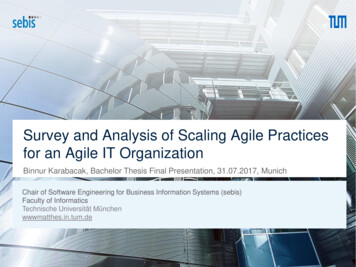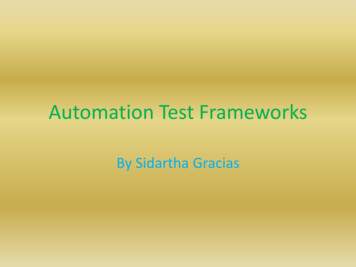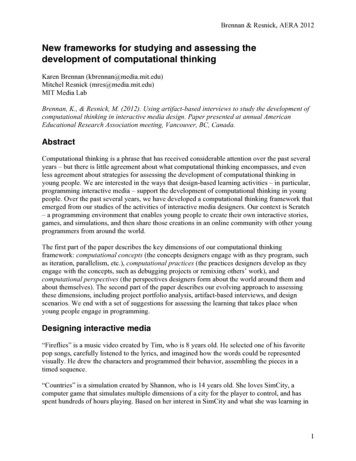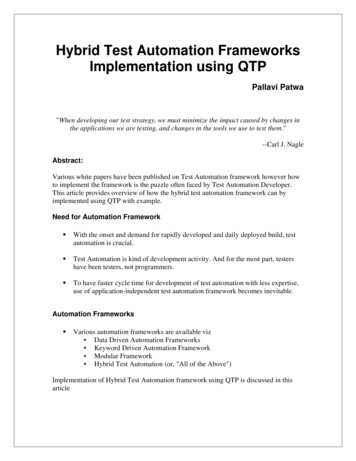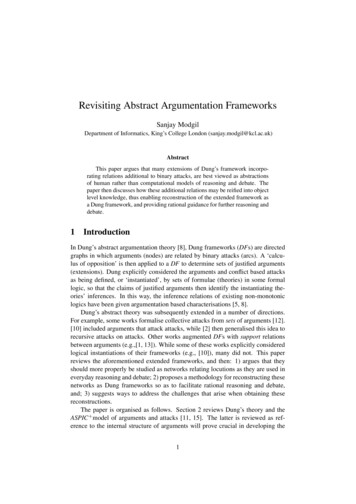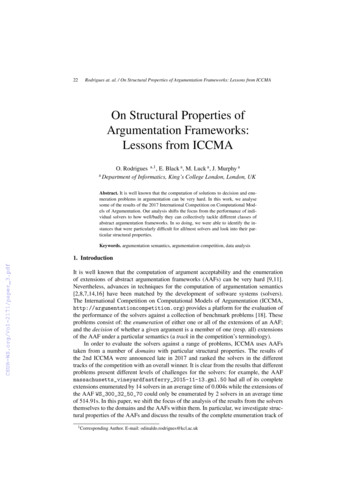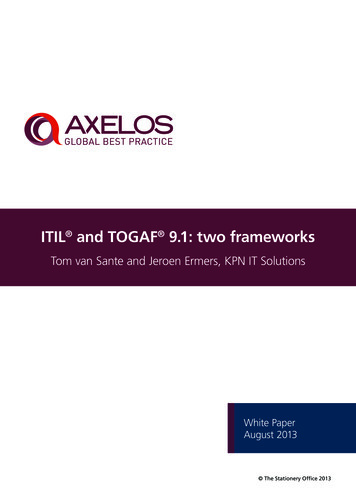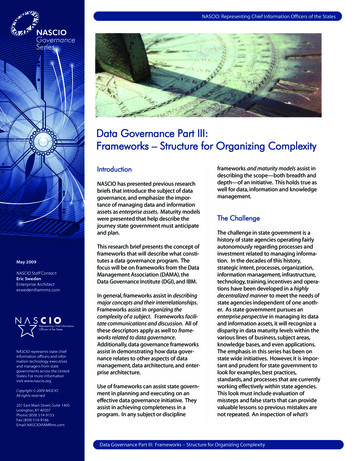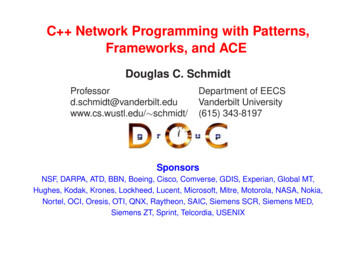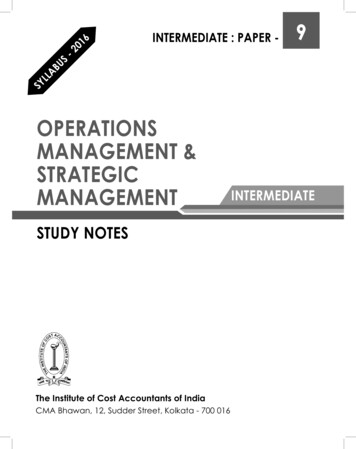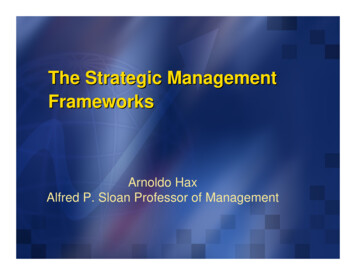
Transcription
The Strategic ManagementFrameworksArnoldo HaxAlfred P. Sloan Professor of Management
The Frameworks for CompetitivePositioning PorterResource-Based View of theFirm The Delta Model
Porter’s Framework for Explaining the Profitability of aBusinessCompetitive PositioningIndustry StructureAchieving sustainablecompetitive advantageFactors affectingindustry profitabilityStrategy Formulationand ImplementationDefining and executingthe managerial tasks
Elements of Industry Structure: Porter’s Five-ForcesGovernment Action- Industry protection- Industry regulation- Consistency of policies- Capital movements among countries- Custom duties- Foreign exchange- Foreign ownership- Assistance provided to competitorsRivalry Among Competitors- Concentration & balance among competitors- Industry growth- Fixed (or storage) cost- Product differentiation- Intermittent capacity increasing- Switching costs- Corporate strategic stakesNew EntrantsThreat of new entrantsBarriers to Entry- Economies of scale- Product differentiation- Brand identification- Switching cost- Access to distribution channels- Capital requirements- Access to latest technology- Experience & learning effectsBarriers to Exit- Asset specialization- One-time cost of exit- Strategic interrelationships with other businesses- Emotional barriers- Government & social restrictionsIndustryCompetitorsIntensityof RivalrySuppliersBuyersPower of Suppliers- Number of important suppliers- Availability of substitutes for the supplier's products- Differentiation or switching cost of supplier's products- Supplier's threat of forward integration- Industry threat of backward integration- Supplier's contribution to quality or service of theindustry products- Total industry cost contributed by suppliers- Importance of the industry to supplier's profitBargaining Power of BuyersThreat ofsubstitutesBargaining Power of SuppliersSubstitutesAvailability of Substitutes- Availability of close substitutes- User's switching costs- Substitute producer's profitability& aggressiveness- Substitute price-valueFigure by MIT OCW.Power of Buyers- Number of important buyers- Availability of substitutes for the industry products- Buyer's switching costs- Buyer's threat of backward integration- Industry threat of forward integration- Contribution to quality or service of buyer's products- Total buyer's cost contributed by the industry- Buyer's profitability
Porter’s Five-Forces Model Applied to thePharmaceutical Industry in the Early 1990sBarriers to Entry (Very Attractive)- Steep R&D experience curve effects- Large economies-of-scale barriers in R&D and sales force- Critical mass in R&D and marketing require global scale- Significant R&D and marketing costs- High risk inherent in the drug development process- Increasing threat of new entrants comingfrom biotechnology companiesBargaining Power of Suppliers(Very Attractive)- Mostly commodities- Individual scientists mayhave some personal leverageBargaining Power of Buyers(Mildly Unattractive)- The traditional purchasing processwas highly price insensitive: theconsumer (the patient) did not buy,and the buyer (the physician) didnot pay- Large power of buyers, particularlyplan sponsors and cost containmentorganizations, are influencing thedecisions to prescribe less expensivedrugs- Mail-order pharmacies are obtaininglarge discounts on volume drugs- Large aggregated buyers (e.g., hospitalsuppliers, large distributors, governmentinstitutions) are progressively replacingthe role of individual customers- Important influence of thegovernment in the regulation of thebuying processIntensityof Rivalry&CompetitionThreat of Substitutes (Mildly Unattractive)- Generic and "Me-too" drugs are weakening branded, proprietary drugs- More than half of the life of the drug patent is spent in the product development and approval process- Technological development is making imitation easier- Consumer aversion to chemical substances erodes the appeal for pharmaceutical drugsIntensity of Rivalry (Attractive)- Global competition concentrated among fifteen large companies- Most companies focus on certain types of disease therapy- Competition among incumbents limited by patent protection- Competition based on price and product differentiation- Government intervention and growth of "Me-too" drugs increase rivalry- Strategic alliances establish collaborative agreements among industry players- Very profitable industry, however with declining marginsFigure by MIT OCW.SUMMARY ASSESSMENT OFTHE INDUSTRY ATTRACTIVENESS(Attractive)
Make a business in an attractive industry where you can excel;then excel by achieving a low cost of differentiation though unique activitiesFirm InfrastructureSUPPORTACTIVITIESHuman Resource ManagementTechnology ions Outbound Marketinglogistics& salesPRIMARY ACTIVITIESTHE VALUE CHAINFigure by MIT OCW.Service
Management InfrastructureVery strong corporate cultureOne of America's best managed companiesSuperb financial management & managerial control capabilitiesVery lean structureHighly concerned about ethics, ecology, and safetyHuman Resources ManagementFriendly & cooperative labor relationsStrong recruiting programs in top universitiesExcellent training & developmentExcellent rewards & health-care programsTechnology DevelopmentTechnology leader; developer of break-path drugs (e.g., Vasotec, Sinement, Mevacor)Intensive R&D spendingStrengthening technological & marketing capabilities through strategic alliances (Astra, DuPont, and Johnson & Johnson)Fastest time-to-market in drug discovery and drug approval processesProcurementMARGINVertical integration in chemical productsInboundLogisticsManufacturingOutbound LogisticsMarketing & SalesServiceIncreasing manufacturingflexibility and cost reductionsAcquisition of Medcoprovides unique distributioncapabilities and informationtechnology supportMarketing leadershipMedco's serviceexcellence has attractedmajor corporationsand health-careorganizations asclients.Stressing quality andproductivity improvementsGlobal facilities networkLarge direct sales staffGlobal marketing coverageMedco is the number onemail-order firmLeverage through Medco,including powerful marketinggroups and sales forces, andproprietary formularyMedco IT infrastructure anddatabase, covering patients,physicians, and drug usesStrategic alliancesMERCK'S VALUE CHAINFigure by MIT OCW.
There are two ways to compete: Low Cost orDifferentiationThe efficiency of the low cost provider’provider’s cost structure allows pricing below the average competitor,which in the long run may put average competitors out of business.business.This is why the alternative to low cost needs to be differentiation,differentiation, offering unique product attributes thatthe customer values and will pay a premium for.Best ProductMargin /UnitMarginMarginCostCostCostAveragePlayerLow CostPlayerDifferentiationPlayerTotal CustomerSolutionsPlayer
However, the Total Customer Solutions positioning offers apossible preferred alternative by introducing significant costsavings (and/or revenue increases) to the customer.Best ProductTotal CustomerSolutionsMarginMargin /UnitMarginMarginCostCostCostAveragePlayerLow CostPlayerDifferentiationPlayerCost
Critical Elements in Porter’s FrameworksFocus of StrategicAttentionPorterIndustry/ BusinessTypes ofCompetitiveAdvantageLow cost orDifferentiationBasic Unit ofCompetitiveAdvantageActivities
Porter’s winning FormulaPick a business in an attractive industry in which you canexcel. Notice that Porter’s Framework stressed rivalry andcompetition. Therefore,an attractive industry is one in whichwe can achieve as close to a monopolistic position aspossible. In turn, the message of the value chain is toachieve sustainable advantage by beating your competitors,if not in all, at least in those activities that are most crucialto competition.Strategy is War!
The Resource-Based View of theFirm Framework
Resources can be classified into three broad categories Tangible assets are the easiest to value, and often are the onlyresources that appear on a firm’s balance sheet. They include realestate, production facilities, and raw materials, among others.Although tangible resources may be essential to a firm’s strategy,due to their standard nature, they rarely are a source ofcompetitive advantage. There are, of course, notable exceptions.
Resources can be classified into three broad categories (Cont’d) Intangible assets include such things as companyreputations,brand names, cultures, technologicalknowledge, patents and trademarks, and accumulatedlearning and experience. These assets often lay animportant role in competitive advantage (ordisadvantage), and firm value.
Resources can be classified into three broad categories (Cont’d) Organizational capabilities are not factor inputs liketangible and intangible assets; they are complexcombinations of assets, people, and processes thatorganizations use to transform inputs into outputs. Thelist of organizational capabilities includes a set ofabilities describing efficiency and effectiveness: lowcost structure, “lean” manufacturing, high qualityproduction, fast product development.Source: David Collis and Cynthia Montgomery
4. Select a strategy which bestexploits the firm's resources andcapabilities relative to externalopportunities.Strategy3. Appraise the rent-generatingpotential of resources andcapabilities in terms of:i) their potential for sustainablecompetitive advantage, andii) the appropriability of theirreturns.CompetitiveAdvantage2. Identity the firm's capabilities:What can the firm do moreeffectively than its rivals?Identify the resources inputs toeach capability, and thecomplexity of each capability.Capabilities1. Identify and classify the firm'sresources. Appraise strengths andweaknesses relative to competitors.Identify opportunities for betterutilization of resources.5. Identify resource gaps whichneed to be filled.Invest in replenishing, augmentingand upgrading the firm's resourcebase.ResourcesA RESOURCE-BASED APPROACH TO STRATEGY ANALYSIS: A PRACTICAL FRAMEWORKFigure by MIT OCW.
SUSTAINABILITYUNIQUE COMPETENCIESSupported by resources andcapabilities owned by the firmLack of substitution andimitation by competitorsGenerating ValueSustaining ValueCOMPETITIVE ADVANTAGERetaining ValueValue not Offsetby CostsAPPROPRIABILITYOPPORTUNISM/TIMINGRetention of value createdinside the firmOffsetting the cost of acquiringresources and capabilitiesTHE RESOURCE-BASED VIEW-ELEMENTS OF COMPETITIVE ADVANTAGEFigure by MIT OCW.
The Resource-Based View of the Firm Wining FormulaDevelop resources and capabilities which are rare,valuable, non-tradeable, that form the basis of the corecompetencies of the firm; make those resultingadvantages sustainable by precluding imitation orsubstitution from competitors; appropriate the resultingeconomic rent by preventing negative hold-up andslack conditions; and make sure that theimplementation process is done in such a way that itsassociated costs do not upset the resulting benefits.It is Strategy by Real Estate!
Comparison of Critical Elements in Porter’s andResource-Based View FrameworksFocus of StrategicAttentionTypes ofCompetitiveAdvantageBasic Unit ofCompetitiveAdvantagePorterResourceBased ViewIndustry/BusinessCorporationLow cost CoreCompetenciesCore Products,StrategicArchitecture
Comparison Among Strategy FrameworksPorterFocus of StrategicAttentionIndustry/BusinessTypes of Compe- Low cost ortitive Advantage DifferentiationBasic Unit ofCompetitiveAdvantageStrategy AsActivitiesResource-BasedViewDelta ModelExtended EnterpriseCorporation(The Firm, The Customer,The Suppliers , TheComplementors)Resources,Capabilities, Core Best Product, TotalCompetenciesCustomer Solutions,System Lock-InCore Products,StrategicArchitectureAdaptive Processes:Operational Effectiveness,Customer Targeting,InnovationReal EstateRivalryBonding
The Delta Model - An integrative strategic frameworkSystem Lock InTotal Customer SolutionBest ProductCustomer Segmentation andCustomer Value PropositionBundle of CompetenciesMission of the Business Business Scope Core CompetenciesCompetitive PositioningIndustry Structure External factors determiningindustry attractiveness Activities that drive profitabilityInnovationBusinessThe Strategic AgendaCustomer TargetingAdaptive Processes Strategic AgendaAggregate and Granular MetricsExperimentation and FeedbackOperational Effectiveness
The Adaptive Processes:Linking Strategy with ExecutionBusiness ModelInnovationOperational EffectivenessCustomer Targeting The process of new productdevelopment Should ensure a continuousstream of new products andservices to maintain thefuture viability of thebusiness The management of the customerinterface Identification and selection ofattractive customers andenhancementof customers’customers’ performance Should establish best revenuei f ttfht t The production anddelivery of productsand services to thecustomer Should produce themost effective costandasset infrastructure tosupport the chosenstrategic position ofthebusiness
Operational Effectiveness: This process isresponsible for the delivery of products andservices to the customer. In a traditional sense,this includes all the elements of the internalsupply chain. Its primary focus is on producingthe most effective cost and asset infrastructureto support the desired strategic position of thebusiness. In a more comprehensive sense,operational effectiveness should expand itsexternal scope to include suppliers, customer,and key complementors, thus establishing anextended supply chain. This process is theheart of a company’s productive engine as wellas its source of capacity and efficiency.
Customer Targeting: This process addressesthe business-to-customer interface. Itencompasses the activities intended to attract,sati
Excellent training & development Excellent rewards & health-care programs Very lean structure Highly concerned about ethics, ecology, and safety Figure by MIT OCW. There are two ways to compete: Low Cost or Differentiation The efficiency of the low cost provider’s cost structure allows pricing below the average competitor, which in the long run may put average competitors out of business .


